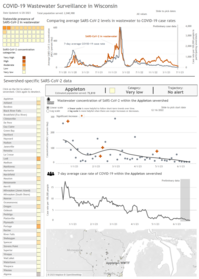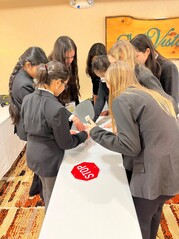HAI Happenings: 2023 Quarter Two Newsletter
This message is being sent to local public health department officers, nurses, and staff; Tribal health directors; infection preventionists; and key DPH staff.
HAI Happenings highlights new and noteworthy topics for all things related to health care-associated infections (HAI), including infection prevention and control (IPC), antimicrobial stewardship (AS), antibiotic resistance, surveillance, and more. You will also be able to find links to helpful guidance and resources and learn more about current Wisconsin HAI Prevention Program activities.
Knowledge check
|
Test your HAI knowledge. See the end of the newsletter for the answer.
Question: As the universal use of source control changes with the end of the public health emergency (PHE), what factors should health care facilities consider when determining how and when to implement broader use of source control?
|
|
 |
What's new with the HAI Prevention Program?
- The HAI Prevention Program, as well as other staff members from the Wisconsin Department of Health Services (DHS), was well represented at the Wisconsin Association for Professionals in Infection Control and Epidemiology (APIC) State Seminar in May. The work being done by the HAI Program and other DHS surveillance programs was highlighted in various presentations. It was great to see so many of you at the conference and we thank all those who contributed to the state seminar this year for their hard work and all the information provided!
- Applications for round two of the Local and Tribal Health Department (LTHD) HAI and Infection Prevention Training Program will open on July 3, 2023. Visit the program webpage to learn more and apply.
- The HAI Program recently updated its webpage focused on HAI surveillance done via the National Healthcare Safety Network (NHSN). The new webpage provides a brief overview of NHSN, information about the main HAI types that health care facilities report in NHSN, and links to reports and websites that utilize NHSN data. The HAI Prevention Program welcomes ideas and suggestions for resources or information that would be most helpful to NHSN users. Please send suggestions to HAI Prevention Program Surveillance and Education Coordinator Nancy Eberle at nancy.eberle@dhs.wisconsin.gov.
Stay in the know on best practices and guidance
- In response to the end of the PHE, CDC released updated COVID-19 guidance for health care settings. This includes specific recommendations for source control in all settings and admission testing in nursing homes, as well as a new appendix to assist facilities with how and when to implement broader use of source control, including examples of potential metrics. The updated guidance focuses on IPC recommendations affected by the discontinuation of the community level and community transmission data metrics with the end of the PHE.
- The Society for Healthcare Epidemiology of America (SHEA) released updated strategies to prevent Clostridioides difficile infections in acute care hospitals.
- New training videos from the CDC are available to help engage, educate, execute, and evaluate hand hygiene programs in health care facilities.
- With the end of the PHE, CMS released updated guidance on staff COVID-19 vaccination mandates in health care facilities. Termination of the omnibus facility staff vaccination requirements officially takes effect on August 4, 2023, but CMS will not enforce the mandate between now and then. CMS will instead pursue monitoring of COVID-19 vaccination similar to influenza vaccination through other quality incentive and reporting programs.
In the news
- On April 12, 2023, the U.S. Food and Drug Administration (FDA) issued a recommendation that consumers, health care providers, and facilities should not use certain surgical N95 respirators manufactured by O&M Halyard, and to use caution with certain surgical masks and pediatric face masks manufactured by O&M Halyard.
- On May 17, 2023, the CDC issued a health advisory to notify health care providers of an outbreak of suspected fungal meningitis among U.S. patients who recently underwent cosmetic procedures under epidural anesthesia in the city of Matamoros, state of Tamaulipas, Mexico. See the HAI Prevention Program Update sent on May 22 for more information and additional resources.
On June 1, 2023, the CDC issued a second health advisory that provides updates on the status of the ongoing fungal meningitis outbreak and highlights interim recommendations for diagnosis and treatment.
Data snapshot
- DHS updated its COVID-19 data webpage as part of continued efforts to provide up-to-date COVID-19 information. The changes include the removal of several data dashboards that no longer accurately reflect COVID-19 transmission. DHS continues to provide hospitalization metrics and wastewater data, as these remain strong indicators of COVID-19 activity. See the Division of Public Health Information Update sent on May 18 for more details.

- Those interested in ongoing activity may wish to review the COVID-19 Wastewater Surveillance in Wisconsin interactive dashboard, which is updated weekly with data from sewersheds around the state. The dashboard includes the following data subsets:
- A waffle chart showing the number of sewersheds within each concentration category
- A graph comparing average SARS-CoV-2 levels at all sewersheds with average COVID-19 case rates for all participating sewersheds
- Concentrations of SARS-CoV-2 virus gene copies in the wastewater normalized by sewage flow and sewershed population
- Daily new COVID-19 case rates within the chosen sewershed
- Wisconsin sewershed locations and boundaries that are included in the monitoring network
|

Western Region Infection Preventionist Nikki Mueller, and the HAI Program’s two health educators, Molly Bieber and Mariah Welke, teamed up to provide a two-day educational workshop at the Wisconsin Health Occupational Students of America (HOSA) State Leadership Conference in April. HOSA is a student organization for middle and high school students interested in health careers.
Workshop participants engaged in an interactive, escape room-style activity to learn more about IPC and engage in practices like hand hygiene, source control, and personal protective equipment. They completed four stations to receive clues to help solve a puzzle at the end.
The team conducted 10 rounds of the escape room and reached 76 high school and middle school students from around the state!
|
Knowledge check answer
Facilities should consider the following factors when determining how and when to implement broader source control mask use:
- The types of patients cared for in the facility.
- Input from partners (including patient and family groups, and health care personnel).
- Plans from other facilities in the jurisdiction with which the facility shares patients.
- What data are available to make decisions.
Additional considerations for implementing broader mask use in health care settings is available in CDC’s Interim Infection Prevention and Control Recommendations for Healthcare Personnel During the Coronavirus Disease 2019 (COVID-19) Pandemic.
Reminder: Masking by health care personnel should be implemented where indicated as part of standard and transmission-based precautions and by ill patients or residents as part of respiratory hygiene and cough etiquette.
|